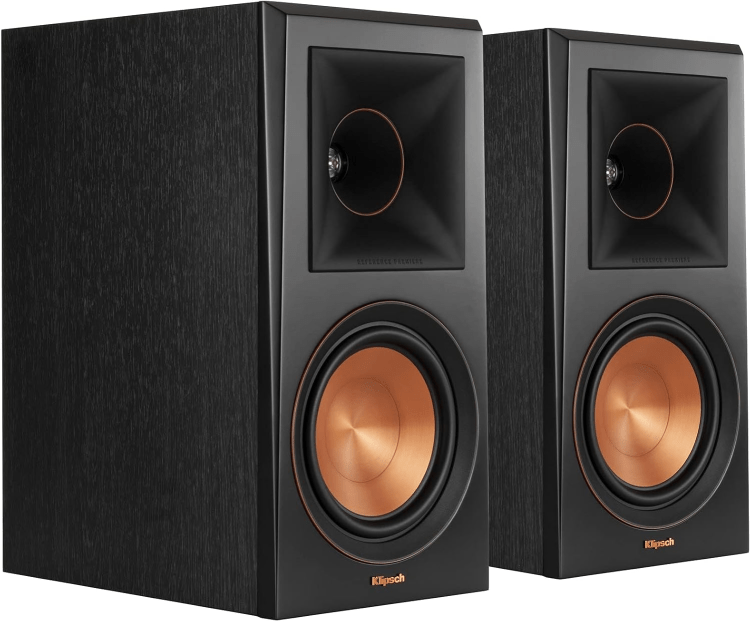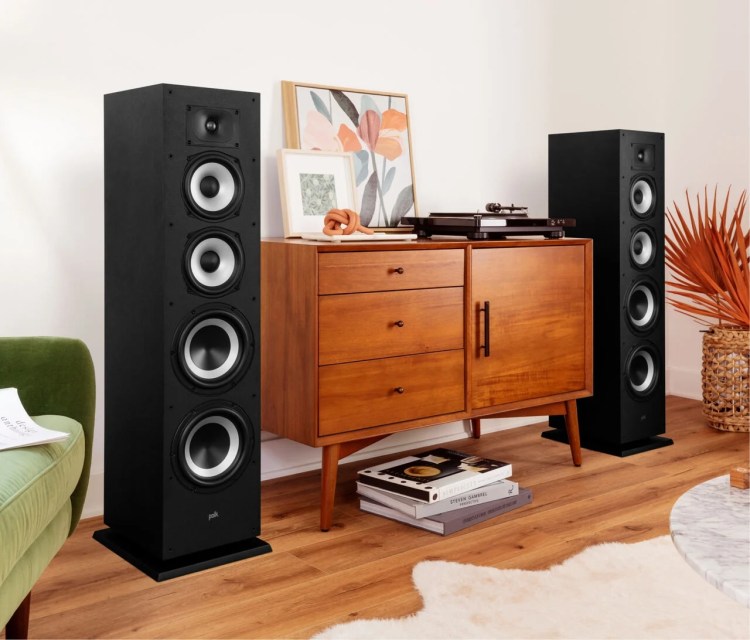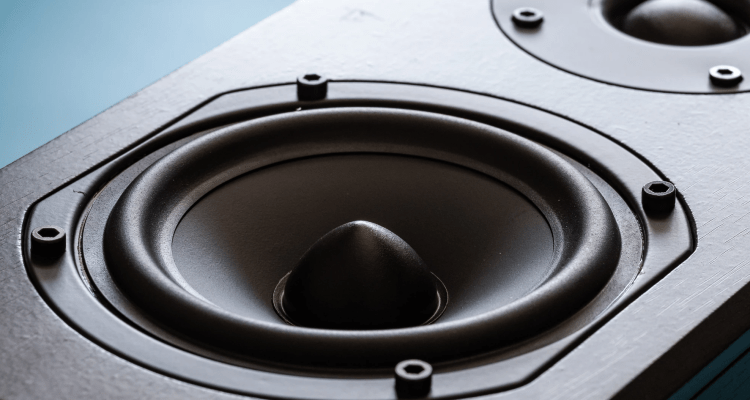If speakers were real estate, bookshelf speakers would be chic city apartments: compact, efficient, and surprisingly stylish. Floorstanders would be suburban houses: bigger, more room to breathe, and capable of throwing a serious party. Both are great places to live with your music—just in different neighborhoods.
The Quick Definitions
- Bookshelf speakers: Small speakers designed to sit on stands, shelves, or a media console. Two drivers on average (a tweeter for highs, a mid/woofer for mids and some bass). They don’t need, much space.
- Floorstanding speakers: Tall speakers that stand on the floor (shocking, I know). Usually more drivers and larger cabinets, which helps them move more air for deeper bass and higher volume.
How They’re Different

1) Size & Placement
Bookshelf: Easy to fit in apartments and multi-use rooms. Best on dedicated stands at ear height, pulled a bit away from the wall.
Floorstanders: Need more room to breathe. They look and sound best with a little space around them—think “furniture you plan around” rather than “box you tuck in.”
2) Bass & Loudness
Bookshelf: Clean, clear mids and highs; bass is there, just not “earthquake.” Add a subwoofer and they punch way above their size.
Floorstanders: Naturally deeper bass and fuller sound right out of the box. Great when you want movie-night rumble without an extra sub.
3) Sound Character
Bookshelf: Often praised for imaging—that spooky “musicians in the room” vibe—especially at moderate volumes.
Floorstanders: Feel effortless and room-filling. They stay composed when you crank it, and they deliver that “front row” concert energy.
4) Room Fit
Small to medium rooms: Bookshelves keep echoes and boom under control and are easier to place.
Medium to large rooms: Floorstanders stretch their legs. They’ll make big rooms feel alive without working too hard.
5) Budget & Upgrade Path
Bookshelf: Usually cheaper per pair, leaving budget for a good sub later. You can build a killer 2.1 or home-theater setup in stages.
Floorstanders: Cost more up front, but you might not need (or want) a sub for music. For home theater, a sub still rocks for the deepest effects.
6) Aesthetics & Practical Stuff
Bookshelf: Minimal footprint; great for desks and media consoles. Stands add cost—but also stability and better sound.
Floorstanders: Statement pieces. Heavier and harder to knock over (pets/kids take note), but you’ll rearrange the room for them.
Which One Should You Pick?
Choose bookshelf speakers if you:
- Live in a smaller space or share walls with neighbors.
- Listen mostly at moderate volumes.
- Want a clean, scalable system (add a sub later).
- Prefer a tidy look or a desk/nearfield setup.
Choose floorstanders if you:
- Have a medium-to-large room and want big, cinematic sound.
- Play music loud and want rich bass without a sub.
- Like the visual presence of tall speakers flanking the TV or turntable.
Are Floor Standing Speakers Better than Bookshelf Speakers?

Short answer: sometimes—but not by default. Floorstanders have physics on their side: bigger cabinets and more drivers mean easier bass and more effortless volume. If you’ve got a roomy living space and you love turning it up, they can feel like opening the windows on a sports car. But “better” depends on your room, your neighbors, and how you actually listen.
In smaller or lively rooms, floorstanders can tip into boomy territory, while good bookshelves stay tight and nimble. Many bookshelf pairs image like champs—voices lock to the screen, guitars hang in space and with a well-placed sub, you’ll get deeper, cleaner low end than most entry-level towers can manage. Plus, bookshelves are easier to position, which is half the battle for good sound.
Think in scenarios:
- Big room, big volume, mostly music? Floorstanders shine. They deliver chesty vocals and kick-drum weight without needing a sub for two-channel listening.
- Smaller room, mixed use (music + TV), shared walls? Bookshelves are friendlier and more flexible; add a sub and you’re in home-theater hero territory.
- Same budget, different builds: A $600 bookshelf pair plus a well-chosen $400 sub often beats a $1,000 tower pair for overall balance and control.
Also consider the human factors: floorstanders take visual center stage (great if you love the look, less great if your partner/roommate doesn’t). Bookshelves can disappear into a room and still deliver that “wow, the singer is right there” moment.
Bottom line: Floorstanders aren’t automatically better; they’re better for some rooms and habits. Bookshelves plus a sub can be the smartest, most neighbor-friendly upgrade path—and they’re easier to get sounding great on day one.
Common Myths
- “Floorstanders are always better.” Not in small rooms. Too much bass can get boomy; a good bookshelf + sub is often smarter.
- “Bookshelves can’t do bass.” Many can go surprisingly low; they just won’t shake drywall solo. Pair them with a sub and they sing.
- “More drivers = better sound.” Design quality matters more than driver count. A well-engineered two-way can beat a bloated three-way.
Setup Basics That Matter More Than You Think
- The triangle thing: Form an equilateral triangle—speaker to speaker equals speaker to your seat.
- Ear-height tweeters: Whether bookshelf-on-stands or floorstanders, aim the tweeters at your ears.
- A little toe-in: Angle speakers slightly toward you for tighter imaging.
- Breathing room: Start with 6–18 inches from the back wall for bookshelves, 12–24 inches for floorstanders, then adjust by ear.
- Sub integration: If you add a sub, begin with an 80 Hz crossover and tweak from there.
Quick Comparison Cheat Sheet
| Feature | Bookshelf Speakers | Floorstanders |
|---|---|---|
| Room Size | Small–Medium | Medium–Large |
| Bass (without sub) | Light–Moderate | Moderate–Deep |
| Volume Headroom | Good | Excellent |
| Placement Flexibility | High | Moderate |
| Cost of Entry | Lower | Higher |
| Visual Impact | Minimal / Compact | Bold / Statement |
Handy Tips
- Stand up for stands: Bookshelves on proper stands sound way better than crammed in a cabinet.
- Mind the furniture: Big reflective TV stands and coffee tables can skew sound—try a rug or small absorbers if things feel shouty.
- Sub smartly: One good sub placed well beats two mediocre ones. Start near a front corner (but not jammed in) and use your receiver’s auto-setup.
- Power match: You don’t need a monster amp. A reliable 50–100 W/ch receiver is plenty for most living rooms.
- Try before you buy: If possible, demo both types with familiar tracks. Online? Choose retailers with easy returns.
- Plan the path: If budget is tight, start with quality bookshelves now; add a sub later; upgrade to floorstanders only if your room and listening habits truly need it.
- Protect your investment: Use rubber feet or spikes to stabilize floorstanders, and cable-manage so kids/pets don’t snag wires.
- Keep it simple: Fewer well-placed speakers usually beat more poorly placed ones.
Bottom line: Small room, modest volume, tidy setup? Go bookshelf (and add a sub when ready). Big room, big sound, big grin? Go floorstander and enjoy the ride.
